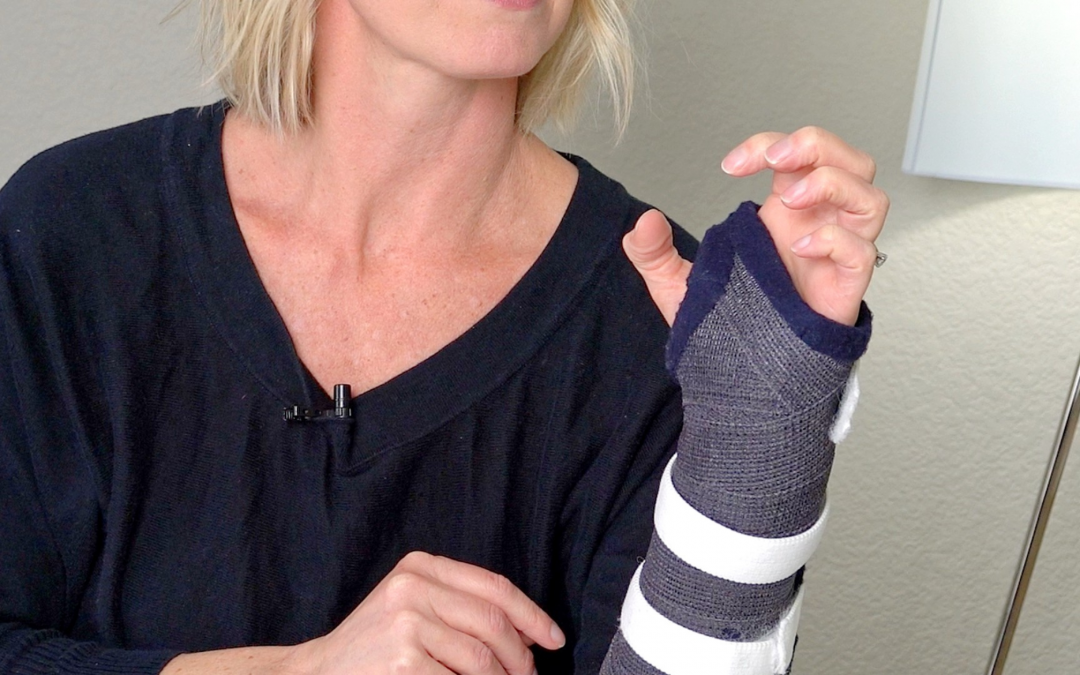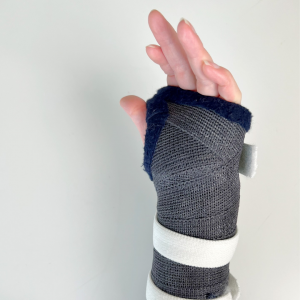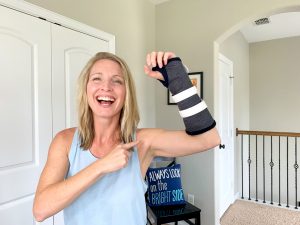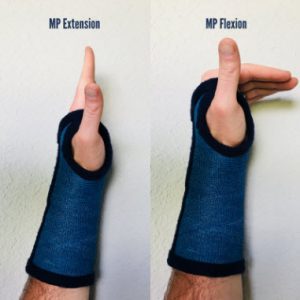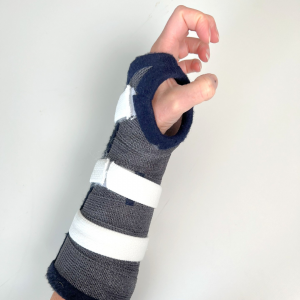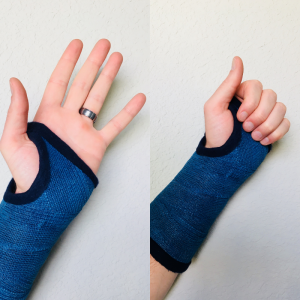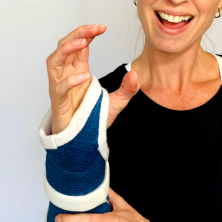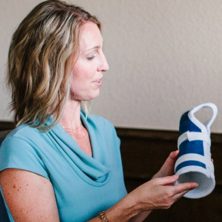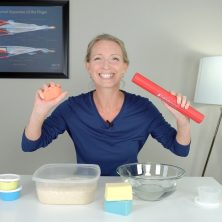Do you want to avoid stiff fingers while wearing a cast? Wiggling fingers in a cast is one of the best things you can do in the beginning stages of your injury recovery.
This can decrease your chances of developing severe finger stiffness and swelling. So, yes, you definitely want to wiggle your fingers if they are free from your cast.
However, it’s important to mention wiggling requires very little active motion.
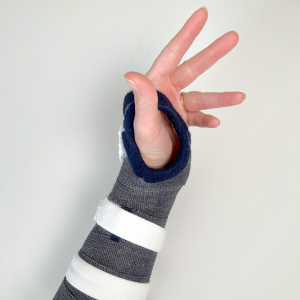
After a few days you should be moving more!
That is why in this blog post, I’ll cover:
- How often you should be wiggling your fingers in your cast.
- When you should be progressing from wiggling to more effective types of movements.
- Finally, stick around for specific exercises that provide more finger motion than wiggling.
Your fingers do so much more than wiggle.
Typically with a broken wrist you are immediately put into a cast, or it’s off to surgery.
Whether you have surgery or not, your wrist will be protected but your fingers will be free.
More than likely, your doctor, or nurse, will give you the wiggling your finger exercise.
Why wiggling fingers in a cast is not enough.
First off, it’s normal for this type of movement to be all you can do in the very beginning.
But as your wrist heals over the next several days and weeks, you it is important to progress from wiggling to more effective exercises.
Here’s what’s wrong with being told to only wiggle your fingers:
- There is not enough emphasis on thumb motion. Most people will only move their fingers, because that is what they are told to do. Therefore your thumb can become very stiff.
- Most of the wiggling motion is performed only at your large knuckles, aka your MP joints.
Give it a try. Notice how the little joints of your fingers, the DIP and PIP joints, don’t move very much if at all.
- If you have a cast that fits high on your large knuckles, aka MP joints, then wiggling won’t provide enough full finger range of motion.
- Often you are not given instruction on dosage and duration. How many times a day are you supposed to wiggle? Once a day for 5 minutes? 5 times a day for 1 minute? All day?
- Typically there is no emphasis on moving your other body parts too. Shoulders and elbows can get very stiff too.
Heck your whole body craves motion.
- Often there is no education, or training, on how to advance your motion safely. After a few days, you will want to move more than what wiggling provides for your fingers.
As you can tell there is a bit more to wiggling your fingers in a cast.
Kickstart your finger motion and grip strength with my GET A GRIP Program
How often should I wiggle my fingers in a cast?
First, if ask your doctor or request to see a hand therapist to get a customized program tailored to you.
As a general rule, you’ll want to move your fingers, elbow, and shoulder at least 5-6 times a day.
This will decrease finger swelling and prevent stiffness from settling in.
In fact, moving any body part, not in your cast, can lead to a better overall recovery.
Of course, the first few days after your injury the last thing you’re probably thinking about is moving your fingers.
So give yourself a few days of rest, then slowly start wiggling your fingers.
Overtime start increasing your range of motion.
Don’t be hard on yourself if you can’t make a full fist.
Take it day by day.
You’ll have good days where your fingers feel loose and then the next day…bam!
Your fingers feel like stiff sausages.
On average your cast will be on your wrist for 4-6 weeks, sometimes longer.
If you only wiggle your fingers for weeks, you’re only going to be able to wiggle your fingers when your cast comes off.
This can lead to stiff, painful, and swollen fingers that can take months to recover.
Luckily, there are several effective exercises to upgrade your wiggling movement safely.
Keep in mind, everyone’s injury, cast, and overall health is different. It can take time to build up your motion. And that is okay.
Also, talk to your doctor if your cast is too loose or too tight. A snug cast is considered normal. A tight cast is not recommended. It can compress your nerves and blood supply to your hand and fingers.
Disclaimer: Always make sure that you check with your doctor before you start any exercise program to your fingers or arm.
Now let’s get into exercises that get you moving more than wiggling.
Follow along progressive finger exercises in a cast.
If you’d like, jump right to the exercises in my YT video here.
Video
Exercise #1: Knuckle Benders in Flexion and Extension
Prop up on your elbow. You can rest your arm on a pillow if that is more comfortable.
Lightly straighten all your fingers and thumb as much as you can. Hold 2-3 seconds.
Then bend all your knuckles down, while keeping the small joints of your fingers straight. Hold 2-3 seconds.
Bend your fingers as far down as you cast will let you.
By holding for a count of 2-3 seconds, you will stretch your joints and ligaments more than when you’re wiggling.
Repeat 5-10 repetitions. Adjust the repetitions for what feels right for you.
Important tip #1: Make sure your little finger bends as much as it can. Sometimes casts are made high up on the pinky finger.
This can severely limit mobility to your small finger which in turn can affect your future grip strength.
If you want to learn whether your cast could be causing stiff fingers, check out my blog post here.
Exercise #2: Hook (or Claw) Fist
This is a movement very different from wiggling but very helpful for keeping the little joints of your fingers loose.
Again wiggling doesn’t let you move the little joints of your fingers. This exercise will.
To do this, gently bend the tip and middle joints, DIP and PIP. Do not bend your knuckles.
Don’t forget your thumb!
If you can only move just a little that’s okay. Eventually you want to flex as far down into a hook, or claw, fist as possible. Then straighten all your fingers after each hook fist.
Repeat 5-10 repetitions.
Important tip #2: Don’t forcefully flex or pull your fingers down too hard. These should be light movements that safely allow your flexor tendons to glide nice and smoothly over your fracture.
In fact, try these on your uninjured hand. You’ll get a better idea of how these exercises should feel. Notice how you don’t need to flex too hard to get those fingers to bend.
Unless of course your fingers are already very stiff.
Exercise #3: Full Fist
In this last exercise, try to combine both exercise #1 and #2 together by flexing your fingers into a full fist. At least as far as your cast will let you.
Bend all 3 joints of your fingers into your palm. Place your thumb on the side of your cast or wherever feels natural. Then straighten your fingers and thumb all the way.
Again make sure your little finger is also bending.
Over time, these exercises should get easier and easier. Then when your cast comes off you’ll be ready to work on your wrist and forearm.
For more exercises follow my 5 Gentle and Safe Finger Exercises in a Wrist Cast blog post here.
Need more finger mobility exercises?
Kickstart your finger motion and grip strength with my GET A GRIP Program

